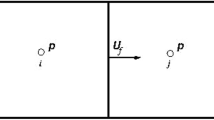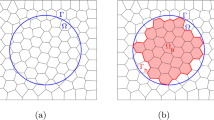Abstract
A local meshless collocation method has been designed for solving reaction–diffusion systems on surfaces. The proposed numerical procedure is based on Pascal polynomial approximation and closest point method. This method is geometrically flexible and can be applied to solving partial differential equations on unstructured point clouds. It only needs a set of arbitrarily scattered mesh-free points representing the underlying surface.




Similar content being viewed by others
References
Barrio RA, Varea C, Aragón JL, Maini PK (1999) A two-dimensional numerical study of spatial pattern formation in interacting Turing systems. Bull Math Biol 61(3):483–505
Chang CW (2016) A new meshless method for solving steady-state nonlinear heat conduction problems in arbitrary plane domain. Eng Anal Bound Elem 70:56–71
Chang W, Zhang J, Wang Y, Wang J (2022) The local meshless method based on Pascal polynomial basis functions for solving fourth-order PDEs. Eng Anal Bound Elem 140:159–166
Chaplain MAJ, Ganesh M, Graham IG (2001) Spatio-temporal pattern formation on spherical surfaces: numerical simulation and application to solid tumour growth. J Math Biol 42:387–423
Chen Y, Macdonald CB (2015) The closest point method and multigrid solvers for elliptic equations on surfaces. SIAM J Sci Comput 37(1):A134–A155
Cheung KC, Ling L (2018) A kernel-based embedding method and convergence analysis for surfaces PDEs. SIAM J Sci Comput 40(1):266–287
Davydov VA, Manz N, Steinbock O, Zykov VS, Müller SC (2000) Excitation fronts on a periodically modulated curved surface. Phys Rev Lett 85(4):868–871
Dehghan M, Mohammadi V (2021) The boundary knot method for solving two-dimensional (advection) reaction-diffusion equation. Int J Numer Methods Heat Fluid Flow 31(1):106–133
Dehghan M, Narimani N (2018) Approximation of continuous surface differential operators with the generalized moving least-squares (GMLS) method for solving reaction-diffusion equation. Comput Appl Math 37(5):6955–6971
Dehghan M, Shirilord A (2022) A fast computational algorithm for computing outer pseudo-inverses with numerical experiments. J Comput Appl Math 408:114128
Dehghan M, Hooshyarfarzin B, Abbaszadeh M (2021) Proper orthogonal decomposition Pascal polynomial-based method for solving Sobolev equation. Int J Numer Methods Heat Fluid Flow 32(7):2506–2542
Fuselier EJ, Wright GB (2013) A high-order kernel method for diffusion and reaction-diffusion equations on surfaces. J Sci Comput 56(3):535–565
Gomatam J, Amdjadi F (1997) Reaction-diffusion equations on a sphere: meandering of spiral waves. Phys Rev E 56(4):3913
Grindrod P, Lewis MA, Murray JD (1991) A geometrical approach to wave-type solutions of excitable reaction-diffusion systems. Proc R Soc A 433(1887):151–164
Lehto E, Shankar V, Wright GB (2017) A radial basis function (RBF) compact finite difference (FD) scheme for reaction-diffusion equations on surfaces. SIAM J Sci Comput 39(5):2129–2151
Liu CS, Kuo CL (2016) A multiple-scale Pascal polynomial triangle solving elliptic equations and inverse Cauchy problems. Eng Anal Bound Elem 62:35–43
Liu CS, Young DL (2016) A multiple-scale Pascal polynomial for 2D Stokes and inverse Cauchy-Stokes problems. J Comput Phys 312:1–13
Liu G, Ma W, Ma H, Zhu L (2018) A multiple-scale higher order polynomial collocation method for 2D and 3D elliptic partial differential equations with variable coefficients. Appl Math Comput 331:430–444
Macdonald CB, Ruuth SJ (2008) Level set equations on surfaces via the closest point method. J Sci Comput 35(2):219–240
Macdonald CB, Ruuth SJ (2010) The implicit closest point method for the numerical solution of partial differential equations on surfaces. SIAM J Sci Comput 31(6):4330–4350
Macdonald CB, Brandman J, Ruuth SJ (2011) Solving eigenvalue problems on curved surfaces using the closest point method. J Comput Phys 230(22):7944–7956
Macdonald CB, Merriman B, Ruuth SJ (2013) Simple computation of reaction-diffusion processes on point clouds. Proc Natl Acad Sci 110(23):9209–9214
Manz N, Davydov VA, Müller SC, Bär M (2003) Dependence of the spiral rotation frequency on the surface curvature of reaction-diffusion systems. Phys Lett A 316(5):311–316
März T, Macdonald CB (2012) Calculus on surfaces with general closest point functions. SIAM J Numer Anal 50(6):3303–3328
Merriman B, Ruuth SJ (2007) Diffusion generated motion of curves on surfaces. J Comput Phys 225(2):2267–2282
Moghaderi H, Dehghan M (2017) Mixed two-grid finite difference methods for solving one-dimensional and two-dimensional Fitzhugh-Nagumo equations. Math Methods Appl Sci 40(4):1170–1200
Murray JD (2001) Mathematical biology II: spatial models and biomedical applications, 3. Springer, New York
Oruç Ö (2019) Numerical solution to the deflection of thin plates using the two-dimensional Berger equation with a meshless method based on multiple-scale Pascal polynomials. Appl Math Model 74:441–456
Oruç Ö (2019) A meshless multiple-scale polynomial method for numerical solution of 3d convection-diffusion problems with variable coefficients. Eng Comput 36(4):1215–1228
Oruç Ö (2020) A meshfree computational approach based on multiple-scale pascal polynomials for numerical solution of a 2d elliptic problem with nonlocal boundary conditions. Int J Comput Methods 17(10):1950080
Oruç Ö (2021) An efficient meshfree method based on Pascal polynomials and multiple-scale approach for numerical solution of 2-D and 3-D second order elliptic interface problems. J Comput Phys 428:110070
Oruç Ö (2023) A strong-form meshfree computational method for plane elastostatic equations of anisotropic functionally graded materials via multiple-scale Pascal polynomials. Eng Anal Boundary Elem 146:132–145
Petković MD, Petković MS (2015) Hyper-power methods for the computation of outer inverses. J Comput Appl Math 278(15):110–118
Petras A, Ling L, Ruuth SJ (2018) An RBF-FD closest point method for solving PDEs on surfaces. J Comput Phys 370:43–57
Petras A, Ling L, Piret C, Ruuth SJ (2019) A least-squares implicit RBF-FD closest point method and applications to PDEs on moving surfaces. J Comput Phys 381:146–161
Piret C (2012) The orthogonal gradients method: a radial basis functions method for solving partial differential equations on arbitrary surfaces. J Comput Phys 231(14):4662–4675
Sbalzarini IF, Hayer A, Helenius A, Koumoutsakos P (2006) Simulations of (an)isotropic diffusion on curved biological surfaces. Biophys J 90(3):878–885
Schwartz P, Adalsteinsson D, Colella P, Arkin AP, Onsum M (2005) Numerical computation of diffusion on a surface. Proc Nat Acad Sci 102(32):11151–11156
Shankar V, Wright GB, Kirby RM, Fogelson AL (2015) A radial basis function (RBF)-finite difference (FD) method for diffusion and reaction-diffusion equations on surfaces. J Sci Comput 63(3):745–768
Steven J (2008) Ruuth, Barry Merriman, A simple embedding method for solving partial differential equations on surfaces. J Comput Appl Math 227(3):1943–1961
Tang Z, Zhuojia F, Chen M, Ling L (2021) A localized extrinsic collocation method for Turing pattern formations on surfaces. Appl Math Lett 122:107534
Turk G (2001) Texture synthesis on surfaces. In: Proceedings of the 28th annual conference on Computer graphics and interactive techniques 347–354
Turk G (1991) Generating textures on arbitrary surfaces using reaction-diffusion. Acm Siggraph Comput Graph 25(4):289–298
Varea C, Aragón JL, Barrio RA (1999) Turing patterns on a sphere. Phys Rev E 60(4):4588–4592
Wang M, Watson D, Li M (2018) The method of particular solutions with polynomial basis functions for solving axisymmetric problems. Eng Anal Bound Elem 90:39–46
Acknowledgements
We thank the three reviewers very much for putting time and energy to investigate the initial manuscript and providing many fruitful recommendations that really helped us to improve the quality of the present article.
Author information
Authors and Affiliations
Corresponding author
Ethics declarations
Conflict of interest
The authors declare that they have no conflict of interest.
Additional information
Publisher's Note
Springer Nature remains neutral with regard to jurisdictional claims in published maps and institutional affiliations.
Rights and permissions
Springer Nature or its licensor (e.g. a society or other partner) holds exclusive rights to this article under a publishing agreement with the author(s) or other rightsholder(s); author self-archiving of the accepted manuscript version of this article is solely governed by the terms of such publishing agreement and applicable law.
About this article
Cite this article
Zamani-Gharaghoshi, H., Dehghan, M. & Abbaszadeh, M. A meshless collocation method based on Pascal polynomial approximation and implicit closest point method for solving reaction–diffusion systems on surfaces. Engineering with Computers 40, 313–322 (2024). https://doi.org/10.1007/s00366-023-01794-y
Received:
Accepted:
Published:
Issue Date:
DOI: https://doi.org/10.1007/s00366-023-01794-y




